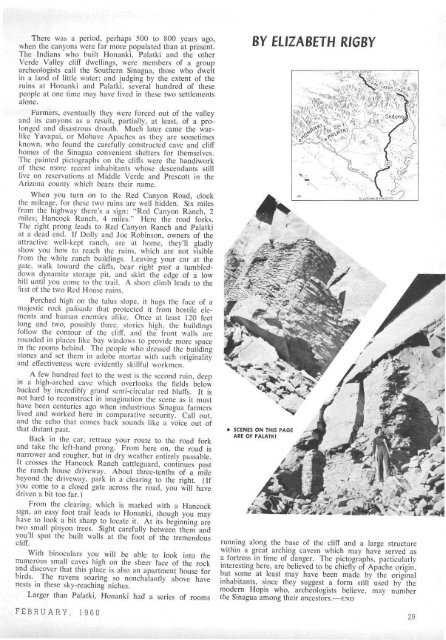Continued - Desert Magazine of the Southwest
Continued - Desert Magazine of the Southwest
Continued - Desert Magazine of the Southwest
You also want an ePaper? Increase the reach of your titles
YUMPU automatically turns print PDFs into web optimized ePapers that Google loves.
There was a period, perhaps 500 to 800 years ago,<br />
when <strong>the</strong> canyons were far more populated than at present.<br />
The Indians who built Honanki, Palatki and <strong>the</strong> o<strong>the</strong>r<br />
Verde Valley cliff dwellings, were members <strong>of</strong> a group<br />
archeologists call <strong>the</strong> Sou<strong>the</strong>rn Sinagua, those who dwelt<br />
in a land <strong>of</strong> little water; and judging by <strong>the</strong> extent <strong>of</strong> <strong>the</strong><br />
ruins at Honanki and Palatki, several hundred <strong>of</strong> <strong>the</strong>se<br />
people at one time may have lived in <strong>the</strong>se two settlements<br />
alone.<br />
Farmers, eventually <strong>the</strong>y were forced out <strong>of</strong> <strong>the</strong> valley<br />
and its canyons as a result, partially, at least, <strong>of</strong> a prolonged<br />
and disastrous drouth. Much later came <strong>the</strong> warlike<br />
Yavapai, or Mohave Apaches as <strong>the</strong>y are sometimes<br />
known, who found <strong>the</strong> carefully constructed cave and cliff<br />
homes <strong>of</strong> <strong>the</strong> Sinagua convenient shelters for <strong>the</strong>mselves.<br />
The painted pictographs on <strong>the</strong> cliffs were <strong>the</strong> handiwork<br />
<strong>of</strong> <strong>the</strong>se more recent inhabitants whose descendants still<br />
live on reservations at Middle Verde and Prescott in <strong>the</strong><br />
Arizona county which bears <strong>the</strong>ir name.<br />
When you turn on to <strong>the</strong> Red Canyon Road, clock<br />
<strong>the</strong> mileage, for <strong>the</strong>se two ruins are well hidden. Six miles<br />
from <strong>the</strong> highway <strong>the</strong>re's a sign: "Red Canyon Ranch, 2<br />
miles; Hancock Ranch, 4 miles." Here <strong>the</strong> road forks.<br />
The right prong leads to Red Canyon Ranch and Palatki<br />
at a dead end. If Dolly and Joe Robinson, owners <strong>of</strong> <strong>the</strong><br />
attractive well-kept ranch, are at home, <strong>the</strong>y'll gladly<br />
show you how to reach <strong>the</strong> ruins, which are not visible<br />
from <strong>the</strong> white ranch buildings. Leaving your car at <strong>the</strong><br />
gate, walk toward <strong>the</strong> cliffs, bear right past a tumbleddown<br />
dynamite storage pit, and skirt <strong>the</strong> edge <strong>of</strong> a low<br />
hill until you come to <strong>the</strong> trail. A short climb leads to <strong>the</strong><br />
aist <strong>of</strong> <strong>the</strong> two Red House ruins.<br />
Perched high on <strong>the</strong> talus slope, it hugs <strong>the</strong> face <strong>of</strong> a<br />
majestic rock palisade that protected it from hostile elements<br />
and human enemies alike. Once at least 120 feet<br />
long and two, possibly three, stories high, <strong>the</strong> buildings<br />
follow <strong>the</strong> contour <strong>of</strong> <strong>the</strong> cliff, and <strong>the</strong> front walls are<br />
rounded in places like bay windows to provide more space<br />
in <strong>the</strong> rooms behind. The people who dressed <strong>the</strong> building<br />
stones and set <strong>the</strong>m in adobe mortar with such originality<br />
and effectiveness were evidently skillful workmen.<br />
A few hundred feet to <strong>the</strong> west is <strong>the</strong> second ruin, deep<br />
in a high-arched cave which overlooks <strong>the</strong> fields below<br />
backed by incredibly grand semi-circular red bluffs. It is<br />
not hard to reconstruct in imagination <strong>the</strong> scene as it must<br />
have been centuries ago when industrious Sinagua farmers<br />
lived and worked here in comparative security. Call out,<br />
and <strong>the</strong> echo that comes back sounds like a voice out <strong>of</strong><br />
that distant past.<br />
Back in <strong>the</strong> car, retrace your route to <strong>the</strong> road fork<br />
and take <strong>the</strong> left-hand prong. From here on, <strong>the</strong> road is<br />
narrower and rougher, but in dry wea<strong>the</strong>r entirely passable.<br />
It crosses <strong>the</strong> Hancock Ranch cattleguard, continues past<br />
<strong>the</strong> ranch house driveway. About three-tenths <strong>of</strong> a mile<br />
beyond <strong>the</strong> driveway, park in a clearing to <strong>the</strong> right. (If<br />
you come to a closed gate across <strong>the</strong> road, you will have<br />
driven a bit too far.)<br />
From <strong>the</strong> clearing, which is marked with a Hancock<br />
sign, an easy foot trail leads to Honanki, though you may<br />
have to look a bit sharp to locate it. At its beginning are<br />
two small pinyon trees. Sight carefully between <strong>the</strong>m and<br />
you'll spot <strong>the</strong> built walls at <strong>the</strong> foot <strong>of</strong> <strong>the</strong> tremendous<br />
cliff.<br />
With binoculars you will be able to look into <strong>the</strong><br />
numerous small caves high on <strong>the</strong> sheer face <strong>of</strong> <strong>the</strong> rock<br />
and discover that this place is also an apartment house for<br />
birds. The ravens soaring so nonchalantly above have<br />
nests in <strong>the</strong>se sky-reaching niches.<br />
Larger than Palatki, Honanki had a series <strong>of</strong> rooms<br />
FEBRUARY, 1960<br />
BY ELIZABETH RIGBY<br />
SCENES ON THIS PAGE<br />
ARE OF PALATKI<br />
fiLi<br />
running along <strong>the</strong> base <strong>of</strong> <strong>the</strong> cliff and a large structure<br />
within a great arching cavern which may have served as<br />
a fortress in time <strong>of</strong> danger. The pictographs, particularly<br />
interesting here, are believed to be chiefly <strong>of</strong> Apache origin,<br />
but some at least may have been made by <strong>the</strong> original<br />
inhabitants, since <strong>the</strong>y suggest a form still used by" <strong>the</strong><br />
modern Hopis who, archeologists believe, may number<br />
<strong>the</strong> Sinagua among <strong>the</strong>ir ancestors.—END<br />
29

















